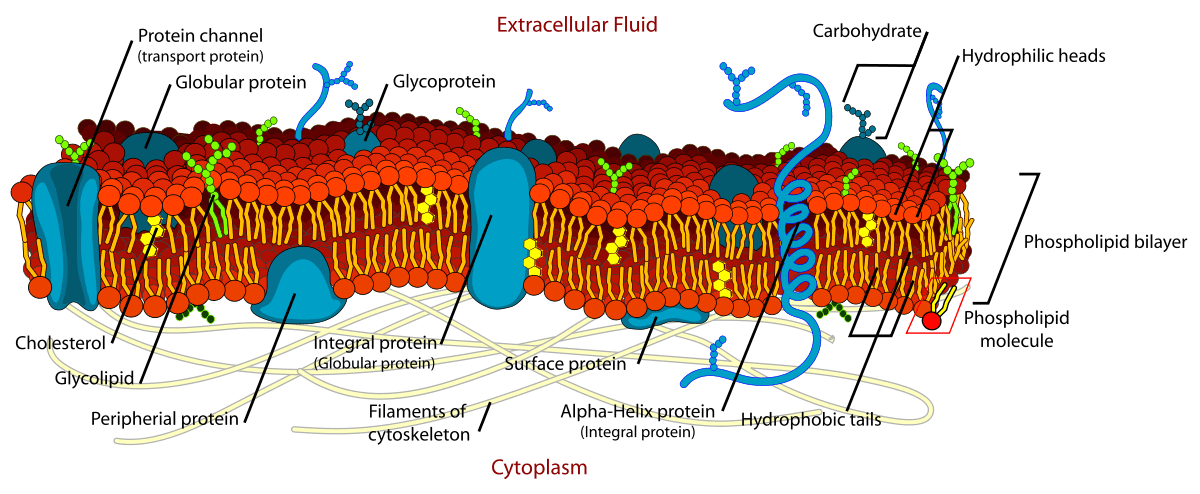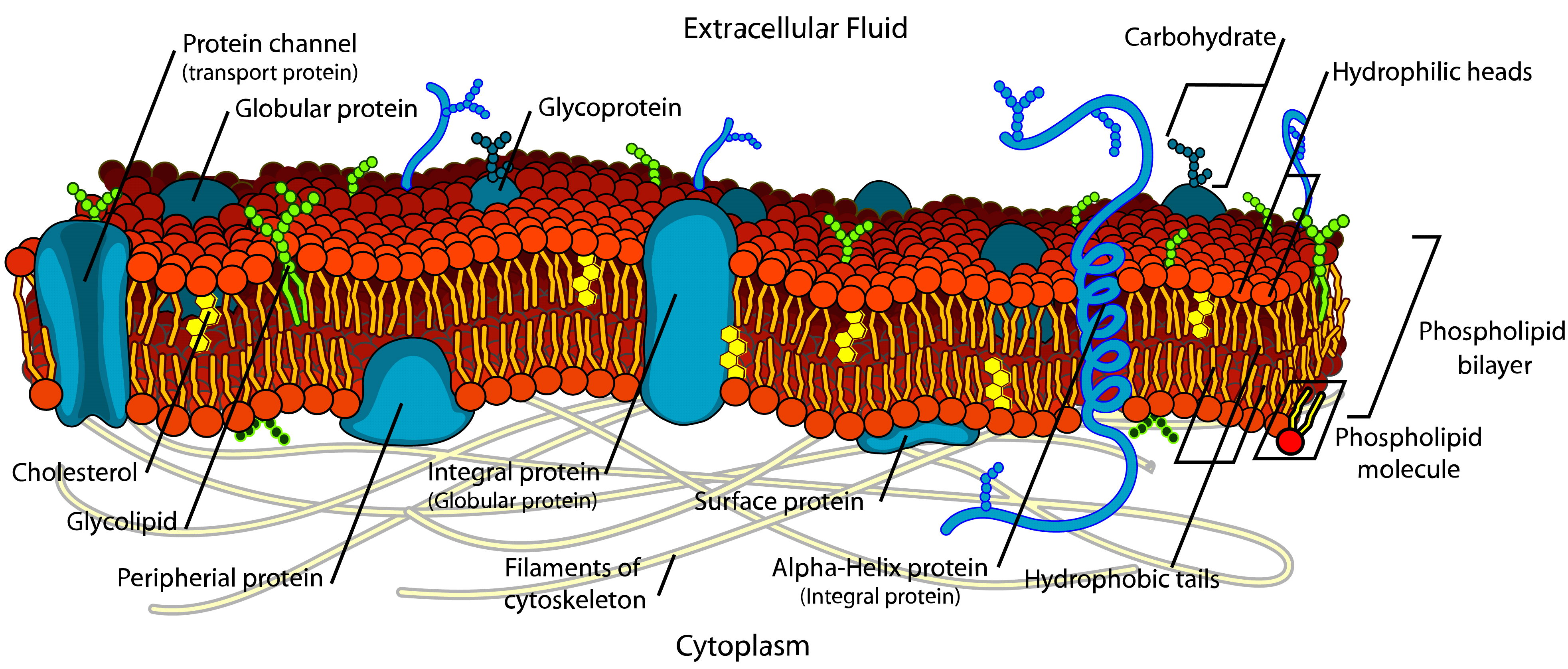
Hey guys! Welcome to this Mometrix video over the functions of the plasma membrane.
The plasma membrane is highly important to the life of a cell! It’s what separates the intracellular environment (the cytoplasm) of cells from the extracellular space into distinct units known as cells. The plasma membrane also regulates the movement of materials in and out of the cell and provides structure to the cells. In this video, we’ll look at what makes the plasma membrane and what it does.
Phospholipid Bilayer
Fluid Mosaic Model

There’s a lot going on in the cell’s membrane! In 1972, S. J. Singer and G. L. Nicolson came up with a model to imagine the cell membrane, known as the fluid mosaic model. This describes the membrane as a fluid phospholipid bilayer containing a mix or mosaic of proteins, cholesterol, and carbohydrates.
To break that down, phospholipids are a type of lipid with hydrophobic (or “water-fearing”) fatty acid tails and a hydrophilic (or “water-loving”) phosphate group as their head. This combination of a hydrophilic and hydrophobic region makes them known as amphipathic. With these arranged side-by-side in two layers, with the tails facing each other and the heads opposite, this makes it a bilayer. The combination of hydrophilic and hydrophobic regions of the bilayer keeps the cell from unwanted leaking of water and other substances. The separate polar and non-polar layers of the membrane keep all but the smallest non-polar molecules such as O2 and CO2 from diffusing across the membrane.
Membrane Fluidity
An important aspect of the phospholipid bilayer is how flexible it is, or its fluidity, which impacts its ability to function as a barrier and as transportation. For this reason, it cannot be too rigid or too fluid and has a varied composition. The fluidity of the bilayer is affected by temperature and the composition of the membrane. With more heat, the membrane becomes more fluid due to the excitement of molecules. Unsaturated fatty acids have double bonds between carbons, which forms a bend or kink, reducing the packing capability of these molecules.
If the membrane was composed entirely of saturated fatty acids, the phospholipid tail would be packed closely side-by-side, and it would be too rigid. However, by incorporating more unsaturated fatty acids, the membrane becomes more fluid. The fluidity of the membrane is also affected by cholesterol and proteins, which are also found in the membrane.
Cholesterol is a type of lipid that is a modified steroid, which contains four carbon rings and a hydrocarbon chain. It reduces membrane fluidity, resists changes in fluidity due to temperature, and also helps prevent materials from leaking through the membrane. Proteins are large, highly functional macromolecules that are found along the plane of the membrane.
Membrane Proteins
A major feature of the plasma membrane is the presence of its membrane proteins. Membrane proteins can either be found on one or both sides of the membrane, and are referred to as peripheral proteins, integral membrane proteins, or transmembrane proteins.
Peripheral proteins are temporarily bound to the membrane by hydrogen bonding or other weak non-covalent interactions and often serve as enzymes or receptor proteins. Integral membrane proteins are those which have hydrophilic and hydrophobic regions that allow them to line up with the hydrophobic region of the membrane and the intracellular or extracellular space.
Transmembrane proteins are integral proteins that have regions exposed in both the cell’s cytoplasm and the extracellular fluid. These integral proteins can drift in the plane of the membrane, but some are stationary.
Passive and Active Transport and Facilitated Diffusion
So we know that most material can’t just easily move through the phospholipid bilayer. Instead, movement of substances in and out of the cell is accomplished through transport proteins found in the membrane. There are two main types of transport proteins: channels and carriers.
Channels are either open or closed to both sides of the cell and allow for the diffusion of hundreds of specific or similar molecules at a time. This type of movement is referred to as passive transport, where substances diffuse down their chemical gradient to the area of a lower concentration.
Carrier proteins are only open on one side at a time and move specific molecules across the membrane that can react with the carrier’s active site, which is where substrates bind to a protein to cause a conformational change, or change in its form and thus function. These carrier proteins are used in active transport, which unlike passive transport, moves substances against their gradient, often to create a high concentration in the cell. Active transport costs energy in the form of ATP to create a conformational change. Another type of transport by carrier proteins is facilitated diffusion, which is a form of passive transport. Polar molecules and large ions can’t move through channel proteins. They move through specific transport proteins to cross the plasma membrane.
Cytoskeleton and Cell Walls
In addition to allowing transport of specific material across the membrane, proteins in the membrane also function as an anchor for the cytoskeleton, a scaffold made of microfilaments, intermediate filaments, and microtubules. It provides stability to the cell and allows for intracellular transport, or movement of objects inside the cell, such as organelles or vacuoles.
Cell Walls
Some cells also feature cell walls. These are thicker structures mostly found surrounding the outside of the plasma membrane in bacteria, plants, and fungi. The structure of the cell wall depends on the type of organism it’s in. In plants, cell walls have three layers: the primary cell wall, secondary cell wall, and middle lamella.
The primary cell walls are made mostly from three polysaccharides: cellulose which forms long, linear chains; hemicellulose, which is a smaller, branching polysaccharide; and pectin.
In the secondary cell wall is primarily cellulose, xylan, and lignin, while the middle lamella is mostly pectin. In bacteria, it is formed primarily of peptidoglycan which forms linear polysaccharide chains cross-linked by peptides. In fungi, the cell wall is formed mostly from chitin, which is a glucose derivative, and polysaccharides, though true fungi do not have cellulose in their cell walls.
I hope that this overview was helpful, see you guys next time!
Frequently Asked Questions
Q
What is the plasma membrane?
A
The plasma membrane, or cell membrane, is a semipermeable membrane within all cells that helps separate the internal parts of the cell from the external environment.
Q
What is the function of the plasma membrane?
A
The plasma membrane acts as a barrier by isolating the cell from its external environment while still enabling the cell to communicate with that outside environment. It also determines what molecules, such as ions, nutrients, and wastes, are allowed to enter and exit the cell.
Q
What is the plasma membrane made of?
A
The plasma membrane is a thin semipermeable membrane of lipids and proteins. It consists of a phospholipid bilayer, or double layer, with the hydrophilic (“water-loving”) ends of the outer layer facing the external environment, the inner layer facing the inside of the cell, and the hydrophobic (“water-fearing”) ends facing each other. Cholesterol in the cell membrane adds stiffness and flexibility. Glycolipids help the cell to recognize other cells of the organisms. The proteins in the cell membrane help give the cells shape. Special proteins help the cell communicate with its external environment, while other proteins transport molecules across the cell membrane.
Q
Do prokaryotes have a plasma membrane?
A
Both prokaryotic and eukaryotic cells have a plasma membrane.
Q
Do plant cells have a plasma membrane?
A
While plant cells are stiffer due to their cell wall, plant cells still contain a plasma membrane.